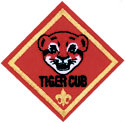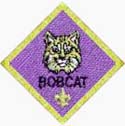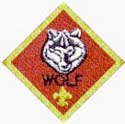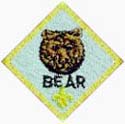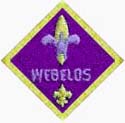What Is Cub Scouting?
Badges of
Cub Scouting
Tiger Cubs
Bobcat
First Rank
Wolf
Bear
Webelos
Arrow of Light
Cub Scouting's
highest awardThe Purposes of Cub Scouting
Since 1930, the Boy Scouts of America has helped younger boys through Cub Scouting. It is a year-round family program designed for boys who are in the first grade through fifth grade (or 7, 8, 9, and 10 years of age). Parents, leaders, and organizations work together to achieve the purposes of Cub Scouting. Currently, Cub Scouting is the largest of the BSA's three membership divisions. (The others are Boy Scouting and Venturing.)
The ten purposes of Cub Scouting are:
- Character Development
- Spiritual Growth
- Good Citizenship
- Sportsmanship
- Family Understanding
- Respectful Relationships
- Personal Achievement
- Friendly Service
- Fun and Adventure
- Preparation for Boy Scouts
Membership
Cub Scouting members join a Cub Scout pack and are assigned to a den, usually a neighborhood group of six to eight boys. Tiger Cubs (first-graders), Wolf Cub Scouts (second graders), Bear Cub Scouts (third graders), and Webelos Scouts (fourth and fifth graders) meet weekly.
Once a month, all of the dens and family members gather for a pack meeting under the direction of a Cubmaster and pack committee. The committee includes parents of boys in the pack and members of the chartered organization.
Cub Scout membership is:
998,207 Cub Scouts* 564,024 Pack Leaders* 830,305 Webelos Scouts* 54,394 Packs* 285,908 Tiger Cub Teams* *As of December 31, 2000 Volunteer Leadership
Thousands of volunteer leaders, both men and women, are involved in the Cub Scout program. They serve in a variety of positions, as everything from unit leaders to pack committee chairmen, committee members, den leader coaches, and chartered organization representatives.
Like other phases of the Scouting program, Cub Scouting is made available to groups having similar interests and goals, including professional organizations; government bodies; and religious, educational, civic, fraternal, business, labor, and citizens' groups. These "sponsors" are called chartered organizations. Each organization appoints one of its members as a chartered organization representative. The organization, through the pack committee, is responsible for providing leadership, the meeting place, and support materials for pack activities.
Who Pays For It?
Groups responsible for supporting Cub Scouting are the boys and their parents, the pack, the chartered organization, and the community. The boy is encouraged to pay his own way by contributing dues each week. Packs also obtain income by working on approved money-earning projects. The community, including parents, supports Cub Scouting through the United Way, Friends of Scouting enrollment, bequests, and special contributions to the BSA local council. This financial support provides leadership training, outdoor programs, council service centers and other facilities, and professional service for units.
Advancement Plan
Recognition is important to young boys. The Cub Scout advancement plan provides fun for the boys, gives them a sense of personal achievement as they earn badges, and strengthens family understanding as adult family members work with boys on advancement projects.
Tiger Cub. The Tiger Cub program is for first grade (or age 7) boys and their adult partners. There are five Tiger Cub achievement areas. The Tiger Cub, working with his adult partner, completes 15 requirements within these areas to earn the Tiger Cub Badge. These requirements consist of an exciting series of indoor and outdoor activities just right for a boy in the first grade.
Bobcat. The Bobcat rank is for all boys who join Cub Scouting.
Wolf. The Wolf program is for boys who have completed first grade (or are age 8). To earn the Wolf badge, a boy must pass twelve achievements involving simple physical and mental skills.
Bear. The Bear rank is for boys who have completed second grade (or are age 9). There are 24 Bear achievements in four categories. The Cub Scout must complete 12 of these to earn the Bear badge. These requirements are somewhat more difficult and challenging than those for Wolf rank.
Webelos. This program is for boys who have completed third grade (or are age 10). A boy may begin working on the Webelos badge as soon as he joins a Webelos den. This is the first step in his transition from the Webelos den to the Boy Scout troop. As he completes the requirements found in the Webelos Scout Book, he will work on activity badges, attend meetings led by adults, and become familiar with the Boy Scout requirements—all leading to the Arrow of Light Award.
Activities
Cub Scouting means "doing." Everything in Cub Scouting is designed to have the boys doing things. Activities are used to achieve the aims of Scouting—citizenship training, character development, and personal fitness.
Many of the activities happen right in the den and pack. The most important are the weekly den meetings and the monthly pack meetings.
Cub Scout Academics and Sports
The Cub Scout Academics and Sports program provides the opportunity for boys to learn new techniques, increase scholarship skills, develop sportsmanship, and have fun. Participation in the program allows boys to be recognized for physical fitness and talent-building activities.
Camping
Age-appropriate camping programs are packed with theme-oriented action that brings Tiger Cubs, Cub Scouts, and Webelos Scouts into the world of imagination. Day camping comes to the boy in neighborhoods across the country; resident camping is at least a three-day experience in which Cub Scouts and Webelos Scouts camp within a developed theme of adventure and excitement. "Cub Scout Worlds" are used by many councils to carry the world of imagination into reality with actual theme structures of castles, forts, ships, etc. Cub Scout pack members enjoy camping in local council camps and council-approved national, state, county, or city parks. Camping programs combine fun and excitement with doing one's best, getting along with others, and developing an appreciation for ecology and the world of the outdoors.
Publications
Volunteers are informed of national news and events through Scouting magazine (circulation 900,000). Boys may subscribe to Boys' Life magazine (circulation 1.3 million). Both are published by the Boy Scouts of America. Also available are a number of Cub Scout and leader publications, including the Tiger Cub Handbook, Wolf Cub Scout Book, Bear Cub Scout Book, Webelos Scout Book, Cub Scout Leader Book, Cub Scout Program Helps, and Webelos Leader Guide.
Cub Scouting Ideals
Apart from the fun and excitement of Cub Scout activities, a number of ideals are expressed in the day-to-day life of the boy and his leaders.
Cub Scout Promise
I, (name), promise to do my best
To do my duty to God and my country,
To help other people, and
To obey the Law of the Pack.Cub Scout Motto
Do Your Best.
Tiger Cub Motto
Search, Discover, Share.
Law of the Pack
The Cub Scout follows Akela.
The Cub Scout helps the pack go.
The pack helps the Cub Scout grow.
The Cub Scout gives goodwill.Colors
The Cub Scout colors are blue and gold. The blue stands for truth and spirituality, steadfast loyalty, and the sky above. The gold stands for warm sunlight, good cheer, and happiness. Together, they symbolize what Cub Scouting is all about.
